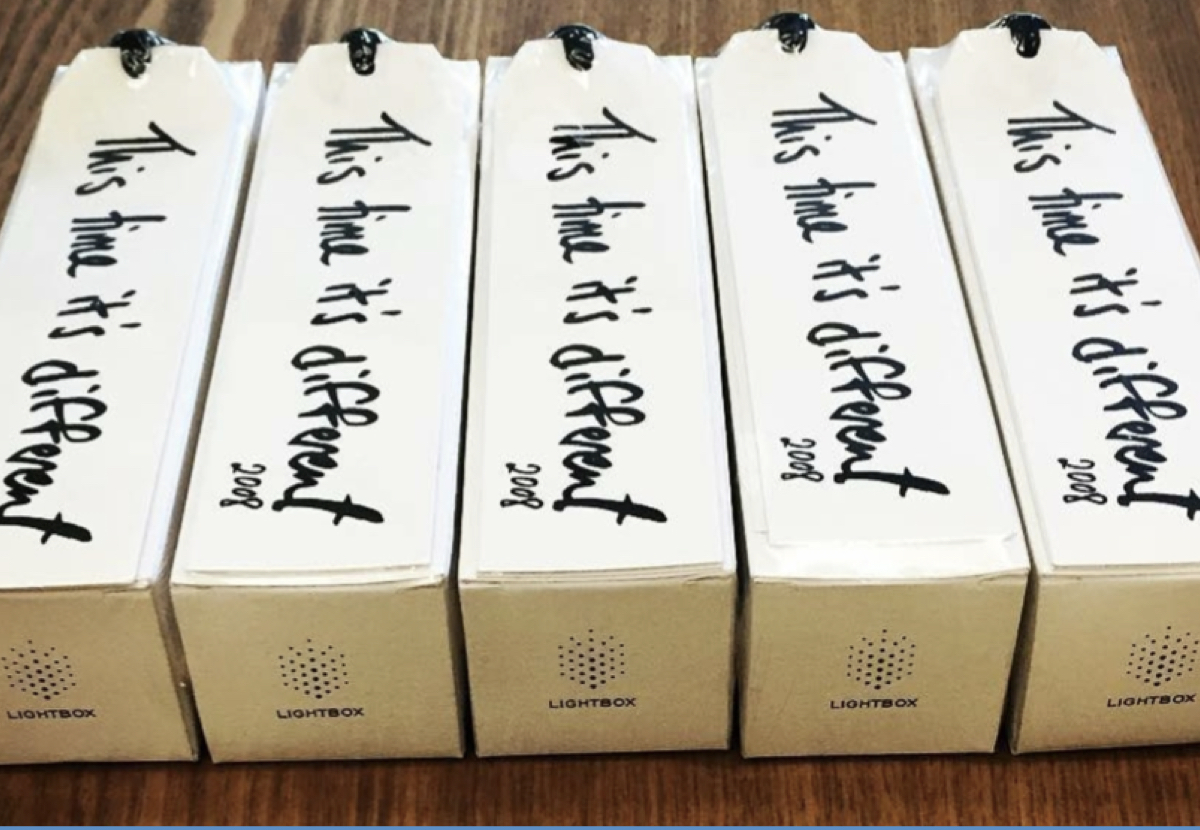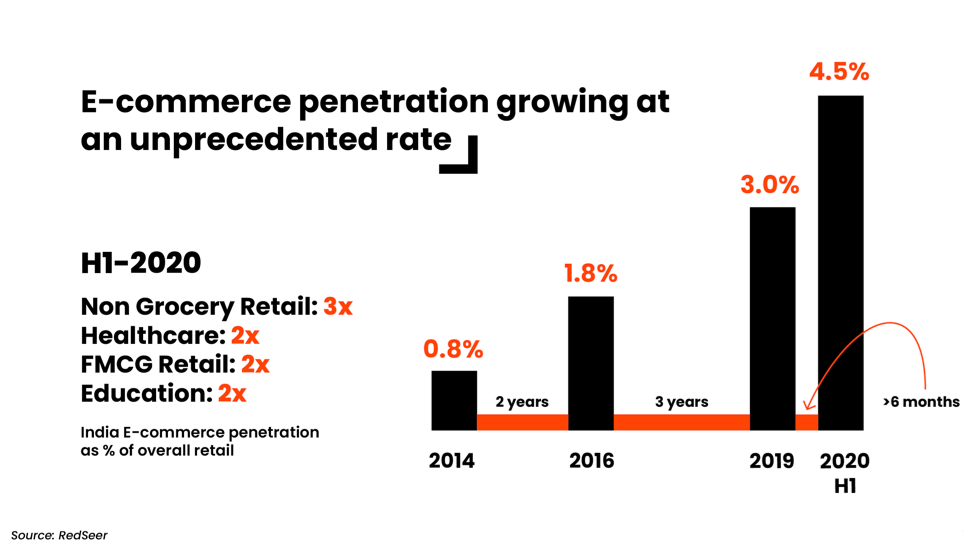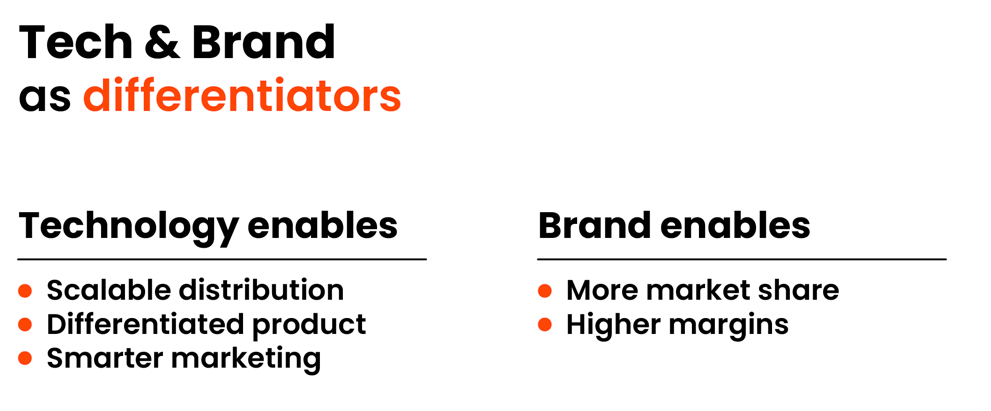


Gradual change doesn't disrupt life. It wears a giant stealth cloak of business as usual, while being pregnant with disruption. And then, sudden change makes everyone sit up!
“The twelve most dangerous words in investing are - The four most dangerous words in investing are, it’s different this time.” This paradoxical saying by Michael Batnick of RitholtzWealth Management in response to John Templeton’s old adage set the tone for our thinking in 2020. Markets are different, consumers are different, times are different, but some themes always play out similarly. At Lightbox, our role is to identify and leverage these themes to create accelerated impact.
The opportunity is massive. India is the last large consumer market being disrupted by technology, with a population of 1.3 billion, 67% of which are working age and contributing 60% to our GDP. India presents several long-standing challenges that serve as low-hanging fruit for tech-enabled businesses to capture. India has recovered spectacularly from the days of the License Raj, when there were few brands with no competition and no compelling reason to invest in product innovation. Smaller brands tended to be fragmented with no capital for expansion and the idea of 'Jugaad' kicked in. Thankfully, that's changing too.

In 2020, we saw several elements that had come together, gradually, then suddenly, leaving India poised for massive growth. There were many changes that occurred in parallel in the last decade, -- consumption per capita grew over 4x, urbanization increased and organized retail boomed. E-commerce grew at an unprecedented rate just in the first half of 2020., growing from 3% in 2019 to 4.5%. All this was on the backdrop of evolving new business models, driven by tech adoption, which grew from 2% in 2000 to nearly 50% in 2019!
Consumer Behavior
Consumer behavior is rapidly changing and we need to understand and forecast changes in preferences to identify great upcoming businesses.
Consumer behavior is being driven by four broad trends
convenience, trust, affordability and aspiration.
Take a look at the used car market, a great example of a disorganized legacy system with multiple pain-points for buyers and sellers. Enter Droom. An end-to-end transaction-based marketplace that streamlines the entire process of buying and selling used cars. Another example of solving an inefficient market is Furlenco (now House of Kieraya). They seized the opportunity to organize the historically fragmented furniture market and introduced a subscription model to Indian consumers for the first time - with accessible rates, rapid delivery and service, top quality standards and a commitment to circularity and sustainability.
Yet another example of the sharing economy being used to increase efficiency and reduce waste is Cityflo. Buses at a 2-minute walk, departing every 10 minutes, offering premium intracity travel as a service. They tackled the burgeoning traffic problem in Mumbai by removing 3,650 cars from the road in 2019.
Innovation in times of crisis
In times of crisis, like the COVID-19 pandemic, consumer habits change and industries accelerate or decelerate. Education is a prime example of this. EdTech users in India doubled YoY to 90 million in 2020. Flinto Class, a “pre-school in a box” which onboarded 320 preschools on its program pre-COVID, had to entirely pivot its business post-pandemic. Launched in May 2020, the new Flinto Class@Home D2C model delivered ready-to-use materials to students every month, delivering top quality education at scale with high engagement and user satisfaction. Demand for some services skyrocketed during the pandemic. Healthcare has been another challenging area during COVID amid the 2020 norm of social distancing. In that backdrop, telemedicine was another advancement. With a baseline of 100, it grew about 1.5x in the first half of 2020, with specialties like mental health and dermatology finding greater adoption during that period. With that in mind, we looked deeper into mental health. India has 200 million people with some form of a mental disorder, over 85% of whom fail to receive any professional help. InnerHour attempts to solve this problem with an omnichannel approach to self-assessment, treatment and monitoring, starting with wellness programs for corporate employees.
The rise of quick direct-to-home commerce was one of the greatest consumer shifts we witnessed. The national lockdown made it difficult for people to buy groceries and other essentials. Large e-commerce platforms like Flipkart and Amazon were not equipped for low-value, high-frequency doorstep deliveries of consumables. Dunzo had already pioneered quick doorstep grocery delivery and gained huge traction as millions of consumers were forced to shift online. Mini-warehouses were launched in May 2021, and already began contributing to 70% of neighborhood GMV.
When adoption involves Switchover Disruption (Product innovation and disruption)
Traditional sectors have sorely missed product innovation as legacy companies generally hold monopolies and categories are fairly commoditized. Menstrual care is such a category. Monopolies do not innovate much and continue to sell the same products without much improvement. Nua is a disruptive new brand that adopts a holistic approach to women’s wellness that transcends products and solves challenges around women's wellness not just once a month, but everyday of the year. The brand engages with customers online and offline with a growing community and the mission of “solving women’s problems that matter.”
India is a unique market where simple replication of outside models does not work. At Lightbox, we invest in brands that leverage technology and emerging business models to sustainably shape the future of consumption in India.
Technology, Brand, Models and Sustainability are the four themes that form the foundation of our investment ideas.
Mixing models (subscription, made on the internet, access over ownership) and markets (used cars, restaurants, furniture) can help design the best consumer experience.
As we looked forward, we thought about fundamental parameters that would influence consumer choices -

and the levers that businesses have to address these are - tech and brand.

Fashion and apparel is a great example of an industry that needs change, with inventory-heavy balance sheets and constant production that leads to environmental damage. Bombay Shirt Company addresses this problem by building a platform for custom clothing that spans sourcing to last-mile delivery with minimal wastage. This infrastructure has easily absorbed other brands such as Korra, _cityof and Pause that cater to different customer needs. Food and agriculture is also an industry filled with fragmentation and wastage. India is one of the largest food producing markets in the world but is known for poor quality and wastage. Waycool addresses this problem by operating an end-to-end platform connecting farmers with consumers. Control over the back-end allows the company to launch multiple high quality brands. The tech-enabled supply chain reduces wastage from the industry average of 32% to just 1% using demand mapping, traceability and quality grading. The healthcare system in India is broken, with monthly medicine expenses being a burden for consumers. Zeno Health serves over a million customers, with a direct-to-consumer gamified approach and affordably priced generics that they manufacture in-house.
To sum up, the opportunity is massive. Using the levers of tech and brand, there is opportunity everywhere - agriculture, finance, healthcare, education, apparel etc. Since the pandemic, India has witnessed the arrival and doubling down of a new set of global investors. Google is set to invest $10 billion in India. Against the backdrop of geopolitical tensions between the US and China, India has emerged as the most exciting venture ecosystem in Asia. The commitment from investors and big tech players like Amazon, Google and Walmart, not to mention homegrown Reliance Jio, has made it a terrific time to be a consumer in India today. Investors have put in $37 billion into early stage tech businesses in India in the last six years.
" Gradual change doesn't disrupt life. It wears a giant stealth cloak of business as usual, while being pregnant with disruption. And then, sudden change makes everyone sit up! "
As we can see, a series of gradual changes over the years have led to a sudden boom. It took 41 years to grow GDP per capita by $221 but only 27 years to increase by $1797. Jewelry marketplace Melorra witnessed 7x ARR growth from October 2018 to February 2020 to $28.7 million, but then spectacular recovery after the initial COVID lull to record $54 million ARR in July 2021. It took 29 years for non-cash transactions to reach $472 million, and then 11 years to reach $4.5 billion. It took five years for India’s internet base to grow to 71 million in 2014, and then 7 years to grow by 634 million. Mobile data usage in India grew 44x in the last four years and users have doubled their usage every year.
We're excited about this change and can't wait to see where the next year takes us..one filled with infinite possibilities.